The Great American Road Trip
It's been six months since I took this trip.... This summer we visited the U.S. for the first time in three years, since the pandemic began. We made a trip to L.A. and then up the coast to Seattle. We spent the last portion of our summer in Cleveland. It's too much to write about all of it, so I'm only going to focus on the road trip between Seattle and Cleveland. This is a trip I had done at age eleven, in 1991, so it had been 31 years since I had seen this stretch of country, and it was entirely new for both Oya and Julia. I've typed the following word-for-word from the notebook I kept during the trip (with a few things added here and there). Note: any off-kilter photos were taken by my 4' tall, 7 1/2-year-old photographer.
***************
Day 1 (July 17): Seattle to Wenatchee
From Everett, followed U.S. 2 over Stevens Pass through Sultan, Goldbar and Leavenworth (which looks like a phony Bavarian village). Peaks totally covered in clouds, but blue skies after the pass. Eastern Washington a different world: arid farmland and rolling hills. Arrived in Wenatchee by evening and had dinner by the river with Doug Head. (Doug was my dad's friend from the Peace Corps in Afghanistan in 1967-68. The last time I had seen him was in Istanbul in 2014, just a few days before Julia was born.) Talked about Peace Corps and about how I ended up in Turkey. The orchard and birds at their house that I remembered from a childhood visit were all gone. They brought out a photo album with pictures of my dad as the best man at their wedding. A lovely home with artifacts from their travels, bedrooms old-fashioned with handmade quilts. Had a comfortable first night. Eastern Washington a good introduction to where we are headed.
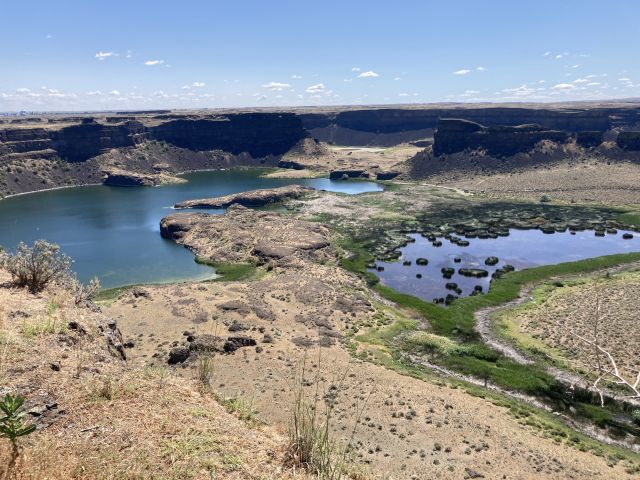
Day 2 (July 18): Wenatchee to Butte
On our way out of town, Doug recommended we stop at Dry Falls, which was once the world's biggest waterfall. Read about how the mega-lake Missoula flooded and carved out the whole area, including the Columbia basin. A heavy driving day that took us across the Idaho panhandle and southeast through Montana to Butte. Impressed as always by the shift in landscape from the dry fields of Eastern Washington to forests and lakes once you hit Idaho. Crossed the Columbia--the first of the big three rivers we will cross on this trip--even wider than I remembered it.
Butte, MT: The city's character is evident in the street names: Copper, Quartz, Galena, Mercury, Silver. A place defined by whatever could be extracted from the earth. Most houses are poor as you drive up the hill past the quarry machinery no longer in use. In the center are mansions of the quarry tycoons. A town where money was made in the crudest way possible. You can imagine the kind of person who lived here then: greedy and unscrupulous. What's left today is a mix of the magnificent and the sad.
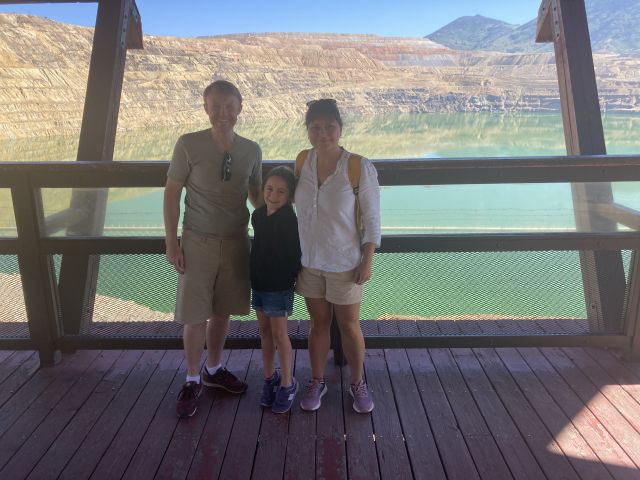
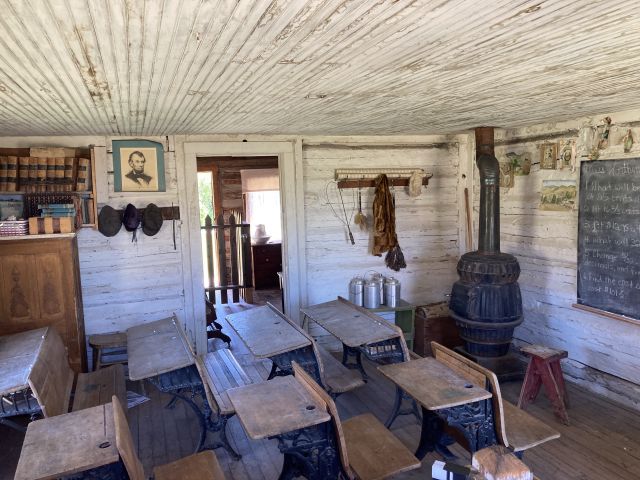
Day 3 (July 19): Butte to Yellowstone
Drove around the streets of Butte in the morning and visited the Berkeley Pit, a quarry flooded with green water, which looks like something from Myst. Drove beautiful HWY 2 out of town and hit Nevada City by noon. Spent an hour in the ghost town. The highlight was the painted two-story house with all its furniture still in place, extremely spooky. A note on the door says the house once belonged to a school teacher who wandered away at a picnic and was never seen again. Arrived in Yellowstone late afternoon. Drove to the "Grand Canyon" and took a hike. Air incredibly thin here. The "Grand View" is the most striking view of the canyon--literally breathtaking. Arrived at our cabin by the Lake late in the evening.
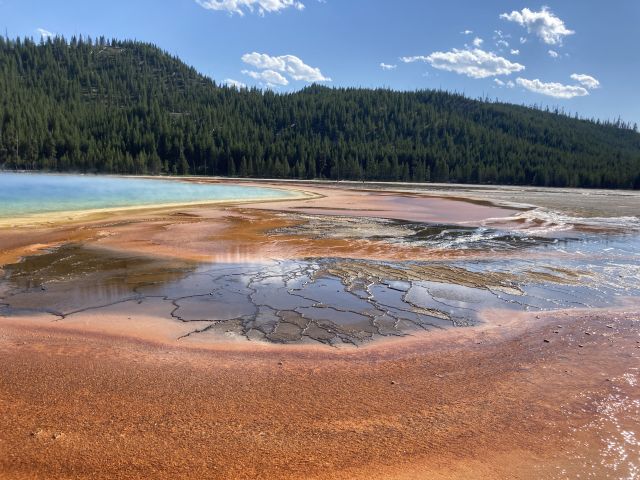
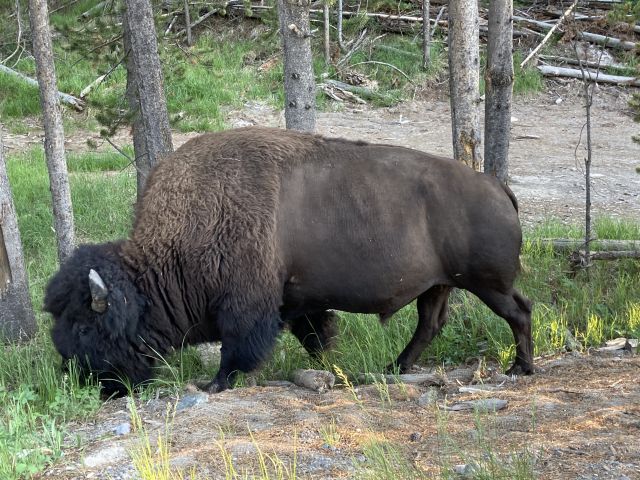
Day 4 (July 20): Yellowstone
After breakfast, we set off for Old Faithful. Spent some time in the lodge, which was the prototype for all National Park Lodges--but in the way that dinosaurs were the prototype for birds that followed. Compared with Paradise at Mt Rainier, it is immense, with its twisting wooden staircases and river rock chimney that reaches up several storeys. We waited for Old Faithful to blow and then took the boardwalk past the other geysers. An otherworldly landscape. We stayed on the west and northwest side of the park. The highlight was Grand Prismatic pool, which is impossibly colorful. The landscape is unlike Mt. Rainier as there are no mountain peaks. Wildlife sightings included bison, a pair of elk, countless ravens--disappointed not to see any large herds this time. Julia got a National Park passport to stamp at each park we stop at, plus a pair of binoculars. In the evening, after dinner, we took a walk through the field in front of the Lake Lodge, bison wandering through the tall grass. Walked down to the lake shore and dipped our feet in the cold water. A great ending to a great day of exploring.
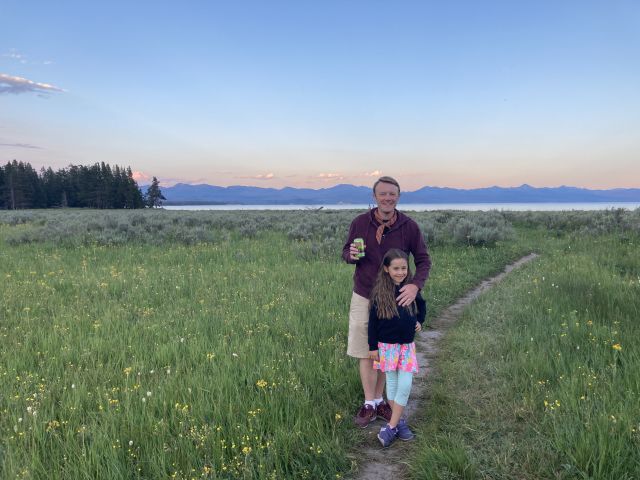
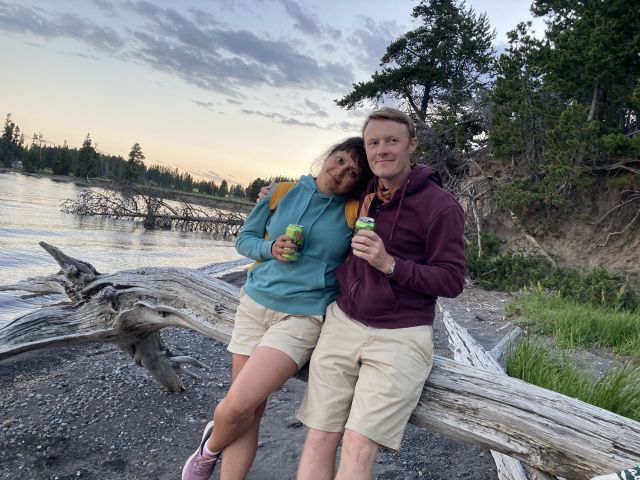
Animals in Wyoming and South Dakota: At Yellowstone are bison that wander up to the side of our car, elk outside the door of our lodge, chipmunks, red squirrels, Brewer's blackbirds, tree swallows, and common ravens, which make the strangest sound, like someone running a stick over the knots of the inside of a hollow log. At Devil's Tower the fields are full of prairie dogs. In the Black Hills, we have to slow down for deer that jump over the road. At Badlands it is a lynx or bobcat, just caught for an instant in the headlights before it disappears into the darkness.
Day 5 (July 21): Yellowstone to Gillette
In the morning, Julia and I took a short walk to see the bison by our lodge. We watched four Brewer's blackbirds land on the back of one while he ate the grass. Took one last walk by the lake before leaving. The rest of the day was spent on the road. Wyoming changes landscape every 50 miles or so. My favorite was the sage-green rolling hills on HWY 120 south of Cody. Such a wild and open place. Real cowboy country. Our route took us up U.S. 16 to Gillette and farther into the heart of the country.
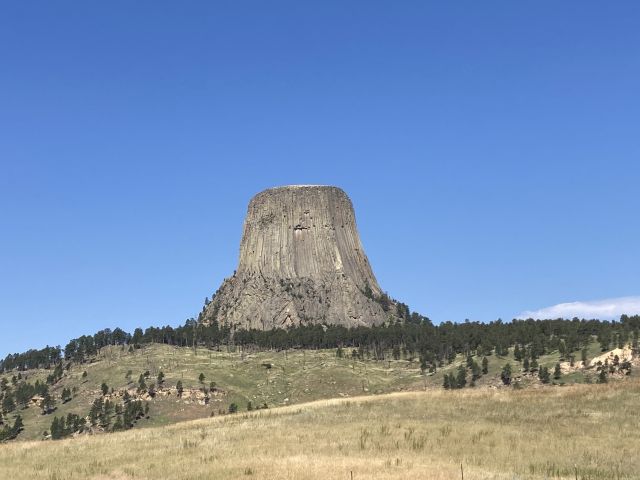
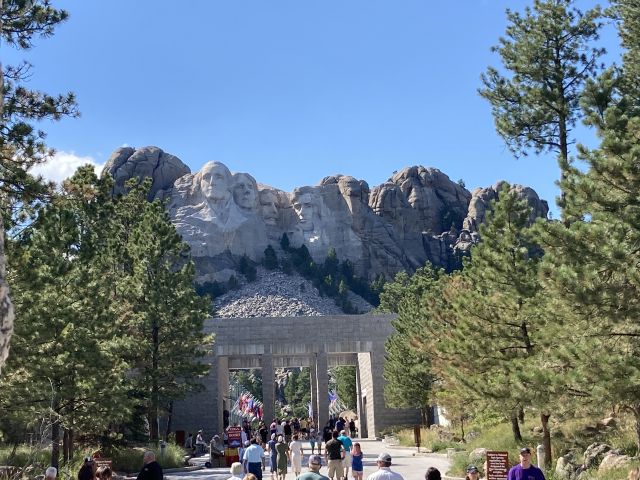
Day 6 (July 22): Gillette to Wall
Began the day driving to Devil's Tower, which I'd never been to up-close. From there another hour to Deadwood, SD, which was very touristy, so we continued on. The Black Hills are beautiful and not what I expected of South Dakota or what I remembered. We stopped at the visitor center on the way. One more hour to Mr. Rushmore. An impressive, even incomparable piece of work and less kitsch than I thought, despite it being a tourist trap. One more hour to Wall. The highlight of the drive is the hand-painted signs for Wall Drug that start around 40 miles outside of town, advertising root beer and hamburgers, cowboy gear and free water. Swam in our motel pool and had sushi in our room. Did not get to Badlands in time for the night program but stopped at the gate to see the stars under a sky as dark as I have ever seen.
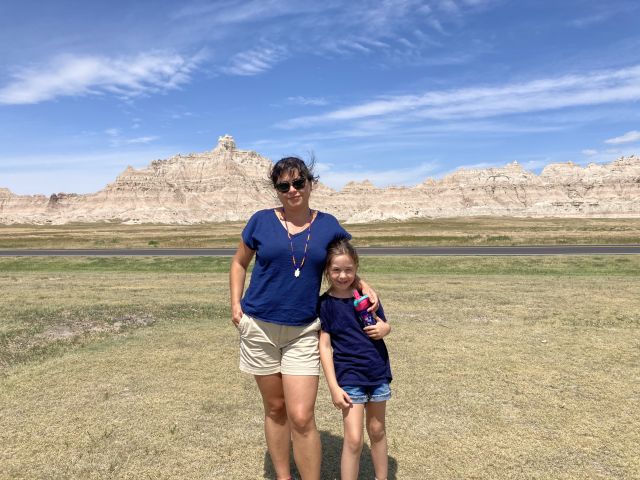
Colors at Badlands: The rock formations seem to simultaneously rise up from the plains but also be exposed by erosion. The primary color is gray, with streaks of red and yellow. In shadow, they appear different, the colors more muted. We are there too late in the morning to see the purple tones at sunrise.
Day 7 (July 23): Wall to Sioux Falls
Started the day at Badlands, essentially one long road with various overlooks. A bit like Cappadocia, in Turkey. Went to the visitor center and took the east exit, which took us to the Minuteman Missile site. We explored the visitor center, which has a great recreation of an underground bunker complete with "the button." But this turned everything around, as we had wanted to see Wall Drug beforehand. Backtracked there and found a horrible tourist trap. By the time we drove back to Minuteman, I ended up missing my tour of the Delta-1 command center by five minutes--but I didn't really want to abandon the girls for an hour (and on Oya's birthday). Long drive through prairie to Sioux Falls. Stopped at an overlook with a massive statue of a Native American woman, looking down on the Missouri below. Tried to imagine Lewis & Clark paddling up the river. Took a walk before returning to the car and saw an alarming sign: BEWARE OF POISONOUS SNAKES. We passed the Corn Palace late in the evening but decided to keep going. The Corn Palace looks like it belongs in some middle-of-nowhere place like Kazakhstan, and in a way this part of South Dakota feels just as distant. Julia and I swam and did the water slides at our hotel, which I had been promising her since the beginning of the trip, and then slept.
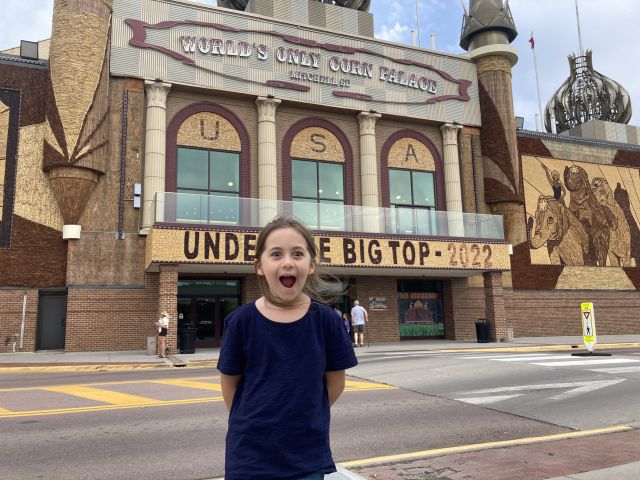
Thoughts on the Minuteman Missile Site: An utterly mundane place just outside of Badlands, and yet here, buried underground, were the most dangerous weapons ever created. I suppose somewhere in Russia there is an identical site with their missile silos dug in farmers' fields. Amazing that anything as terrible as this has ever existed (and still does): a couple of hundred two-man crews waiting for a signal to initiate the end of humanity.
Day 8 (July 24): Sioux Falls to Chicago
Long, boring drive across Minnesota, part of Wisconsin and a bit of Illinois. We stopped for a few minutes in the town of Blue Earth, MN, which has a 55-foot statue of the Jolly Green Giant in a small city park. The one great sight was crossing the Mississippi between MN and WI, much bluer this far north (compared to Natchez, MS four years ago). Made it to Chicago around 9:00 PM, all lit up as we came into town, and found our Airbnb, a pink wooden house near the Ukrainian Village. Nice, tree-lined streets, but not as nice as Lincoln Park. Great to stay in an old house in a city like this.
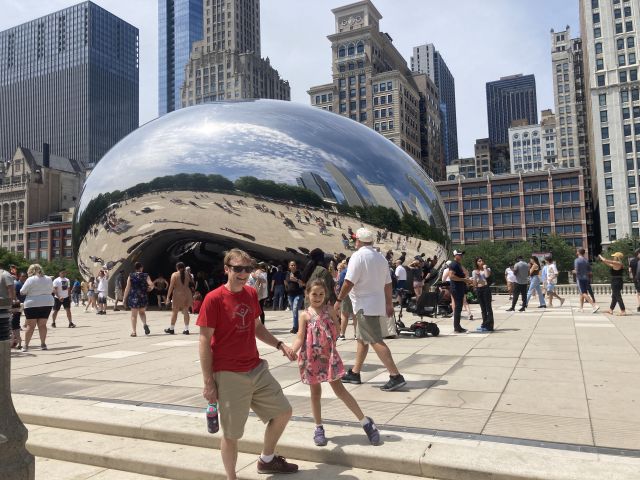
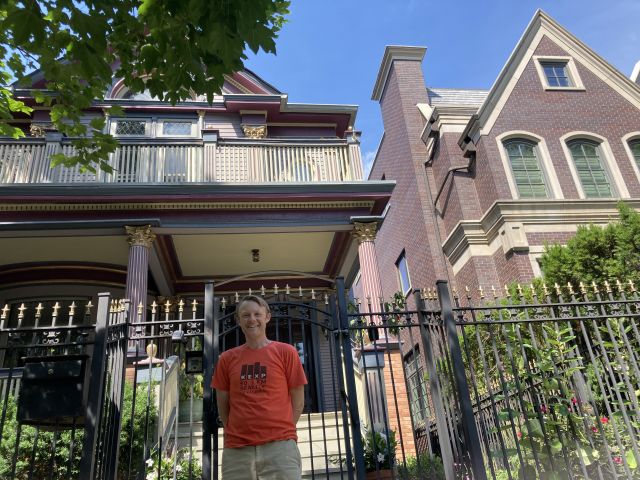
Day 9 (July 25): Chicago
After breakfast drove downtown and parked by Millenium Park. Saw "the Bean" and had a hot dog before heading to the Art Institute. Saw Impressionist, Egyptian and Greek wings plus Miniature Rooms (everyone's favorite) and Chagall Windows. Took the brown line up to Chicago stop and walked to American Girl by the old water tower for Julia. Ate deep dish pizza at Giordano's (ugh). Passed the Poetry Foundation, but it was closed. Took the brown line back to the Loop. I looked at two interesting books at the pink house: Frank Lloyd Wright, plus one on "Lost Chicago."
Chicago After 20 Years: The city is a lesser (?) and more manageable New York. The geography radiates away from the water instead of being surrounded by it. From the L-train there is clearly a style to the skyline, more consistent than NYC. Despite the Art Institute and the other hubs, there is a distinctly blue collar feeling to the town. It is less ostentatious but also in better shape, not so worn-down. The bridges over the Chicago River are its most distinctive feature, both strong and elegant, and probably sum up the city best. I still love it as much as I did when I discovered it in 2002.
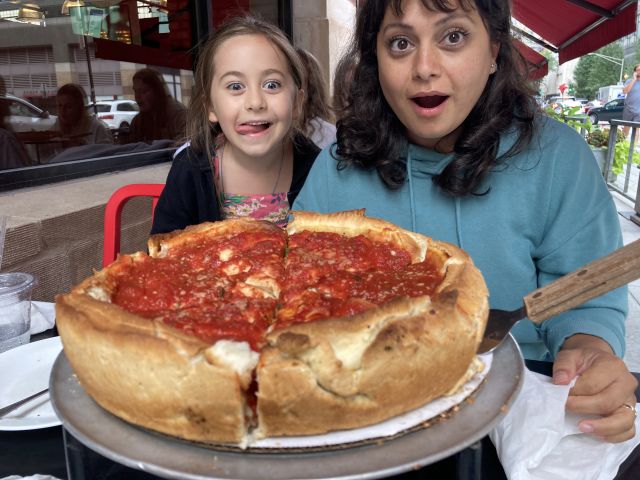
Day 10 (July 26): Chicago to Cleveland
Before we left the city, we stopped at Billy Corgan's old house on Greenview--still purple. We listened to Mellon Collie & the Infinite Sadness as we drove south on Lake Shore Dirve, taking in one last great view of the city. The drive across Indiana on the tollway was unremarkable. I considered driving down to West Lafayette to show Oya and Julia where I once lived, but it would have added at least two hours to the drive. I wonder if I'll ever be that close again. We arrived in Cleveland after sunset, just in time to see the first fireflies. This was our final stop, after 3,000 miles across country.
***************
Day 1 (July 17): Seattle to Wenatchee
From Everett, followed U.S. 2 over Stevens Pass through Sultan, Goldbar and Leavenworth (which looks like a phony Bavarian village). Peaks totally covered in clouds, but blue skies after the pass. Eastern Washington a different world: arid farmland and rolling hills. Arrived in Wenatchee by evening and had dinner by the river with Doug Head. (Doug was my dad's friend from the Peace Corps in Afghanistan in 1967-68. The last time I had seen him was in Istanbul in 2014, just a few days before Julia was born.) Talked about Peace Corps and about how I ended up in Turkey. The orchard and birds at their house that I remembered from a childhood visit were all gone. They brought out a photo album with pictures of my dad as the best man at their wedding. A lovely home with artifacts from their travels, bedrooms old-fashioned with handmade quilts. Had a comfortable first night. Eastern Washington a good introduction to where we are headed.

Day 2 (July 18): Wenatchee to Butte
On our way out of town, Doug recommended we stop at Dry Falls, which was once the world's biggest waterfall. Read about how the mega-lake Missoula flooded and carved out the whole area, including the Columbia basin. A heavy driving day that took us across the Idaho panhandle and southeast through Montana to Butte. Impressed as always by the shift in landscape from the dry fields of Eastern Washington to forests and lakes once you hit Idaho. Crossed the Columbia--the first of the big three rivers we will cross on this trip--even wider than I remembered it.
Butte, MT: The city's character is evident in the street names: Copper, Quartz, Galena, Mercury, Silver. A place defined by whatever could be extracted from the earth. Most houses are poor as you drive up the hill past the quarry machinery no longer in use. In the center are mansions of the quarry tycoons. A town where money was made in the crudest way possible. You can imagine the kind of person who lived here then: greedy and unscrupulous. What's left today is a mix of the magnificent and the sad.


Day 3 (July 19): Butte to Yellowstone
Drove around the streets of Butte in the morning and visited the Berkeley Pit, a quarry flooded with green water, which looks like something from Myst. Drove beautiful HWY 2 out of town and hit Nevada City by noon. Spent an hour in the ghost town. The highlight was the painted two-story house with all its furniture still in place, extremely spooky. A note on the door says the house once belonged to a school teacher who wandered away at a picnic and was never seen again. Arrived in Yellowstone late afternoon. Drove to the "Grand Canyon" and took a hike. Air incredibly thin here. The "Grand View" is the most striking view of the canyon--literally breathtaking. Arrived at our cabin by the Lake late in the evening.


Day 4 (July 20): Yellowstone
After breakfast, we set off for Old Faithful. Spent some time in the lodge, which was the prototype for all National Park Lodges--but in the way that dinosaurs were the prototype for birds that followed. Compared with Paradise at Mt Rainier, it is immense, with its twisting wooden staircases and river rock chimney that reaches up several storeys. We waited for Old Faithful to blow and then took the boardwalk past the other geysers. An otherworldly landscape. We stayed on the west and northwest side of the park. The highlight was Grand Prismatic pool, which is impossibly colorful. The landscape is unlike Mt. Rainier as there are no mountain peaks. Wildlife sightings included bison, a pair of elk, countless ravens--disappointed not to see any large herds this time. Julia got a National Park passport to stamp at each park we stop at, plus a pair of binoculars. In the evening, after dinner, we took a walk through the field in front of the Lake Lodge, bison wandering through the tall grass. Walked down to the lake shore and dipped our feet in the cold water. A great ending to a great day of exploring.


Animals in Wyoming and South Dakota: At Yellowstone are bison that wander up to the side of our car, elk outside the door of our lodge, chipmunks, red squirrels, Brewer's blackbirds, tree swallows, and common ravens, which make the strangest sound, like someone running a stick over the knots of the inside of a hollow log. At Devil's Tower the fields are full of prairie dogs. In the Black Hills, we have to slow down for deer that jump over the road. At Badlands it is a lynx or bobcat, just caught for an instant in the headlights before it disappears into the darkness.
Day 5 (July 21): Yellowstone to Gillette
In the morning, Julia and I took a short walk to see the bison by our lodge. We watched four Brewer's blackbirds land on the back of one while he ate the grass. Took one last walk by the lake before leaving. The rest of the day was spent on the road. Wyoming changes landscape every 50 miles or so. My favorite was the sage-green rolling hills on HWY 120 south of Cody. Such a wild and open place. Real cowboy country. Our route took us up U.S. 16 to Gillette and farther into the heart of the country.


Day 6 (July 22): Gillette to Wall
Began the day driving to Devil's Tower, which I'd never been to up-close. From there another hour to Deadwood, SD, which was very touristy, so we continued on. The Black Hills are beautiful and not what I expected of South Dakota or what I remembered. We stopped at the visitor center on the way. One more hour to Mr. Rushmore. An impressive, even incomparable piece of work and less kitsch than I thought, despite it being a tourist trap. One more hour to Wall. The highlight of the drive is the hand-painted signs for Wall Drug that start around 40 miles outside of town, advertising root beer and hamburgers, cowboy gear and free water. Swam in our motel pool and had sushi in our room. Did not get to Badlands in time for the night program but stopped at the gate to see the stars under a sky as dark as I have ever seen.

Colors at Badlands: The rock formations seem to simultaneously rise up from the plains but also be exposed by erosion. The primary color is gray, with streaks of red and yellow. In shadow, they appear different, the colors more muted. We are there too late in the morning to see the purple tones at sunrise.
Day 7 (July 23): Wall to Sioux Falls
Started the day at Badlands, essentially one long road with various overlooks. A bit like Cappadocia, in Turkey. Went to the visitor center and took the east exit, which took us to the Minuteman Missile site. We explored the visitor center, which has a great recreation of an underground bunker complete with "the button." But this turned everything around, as we had wanted to see Wall Drug beforehand. Backtracked there and found a horrible tourist trap. By the time we drove back to Minuteman, I ended up missing my tour of the Delta-1 command center by five minutes--but I didn't really want to abandon the girls for an hour (and on Oya's birthday). Long drive through prairie to Sioux Falls. Stopped at an overlook with a massive statue of a Native American woman, looking down on the Missouri below. Tried to imagine Lewis & Clark paddling up the river. Took a walk before returning to the car and saw an alarming sign: BEWARE OF POISONOUS SNAKES. We passed the Corn Palace late in the evening but decided to keep going. The Corn Palace looks like it belongs in some middle-of-nowhere place like Kazakhstan, and in a way this part of South Dakota feels just as distant. Julia and I swam and did the water slides at our hotel, which I had been promising her since the beginning of the trip, and then slept.

Thoughts on the Minuteman Missile Site: An utterly mundane place just outside of Badlands, and yet here, buried underground, were the most dangerous weapons ever created. I suppose somewhere in Russia there is an identical site with their missile silos dug in farmers' fields. Amazing that anything as terrible as this has ever existed (and still does): a couple of hundred two-man crews waiting for a signal to initiate the end of humanity.
Day 8 (July 24): Sioux Falls to Chicago
Long, boring drive across Minnesota, part of Wisconsin and a bit of Illinois. We stopped for a few minutes in the town of Blue Earth, MN, which has a 55-foot statue of the Jolly Green Giant in a small city park. The one great sight was crossing the Mississippi between MN and WI, much bluer this far north (compared to Natchez, MS four years ago). Made it to Chicago around 9:00 PM, all lit up as we came into town, and found our Airbnb, a pink wooden house near the Ukrainian Village. Nice, tree-lined streets, but not as nice as Lincoln Park. Great to stay in an old house in a city like this.


Day 9 (July 25): Chicago
After breakfast drove downtown and parked by Millenium Park. Saw "the Bean" and had a hot dog before heading to the Art Institute. Saw Impressionist, Egyptian and Greek wings plus Miniature Rooms (everyone's favorite) and Chagall Windows. Took the brown line up to Chicago stop and walked to American Girl by the old water tower for Julia. Ate deep dish pizza at Giordano's (ugh). Passed the Poetry Foundation, but it was closed. Took the brown line back to the Loop. I looked at two interesting books at the pink house: Frank Lloyd Wright, plus one on "Lost Chicago."
Chicago After 20 Years: The city is a lesser (?) and more manageable New York. The geography radiates away from the water instead of being surrounded by it. From the L-train there is clearly a style to the skyline, more consistent than NYC. Despite the Art Institute and the other hubs, there is a distinctly blue collar feeling to the town. It is less ostentatious but also in better shape, not so worn-down. The bridges over the Chicago River are its most distinctive feature, both strong and elegant, and probably sum up the city best. I still love it as much as I did when I discovered it in 2002.

Day 10 (July 26): Chicago to Cleveland
Before we left the city, we stopped at Billy Corgan's old house on Greenview--still purple. We listened to Mellon Collie & the Infinite Sadness as we drove south on Lake Shore Dirve, taking in one last great view of the city. The drive across Indiana on the tollway was unremarkable. I considered driving down to West Lafayette to show Oya and Julia where I once lived, but it would have added at least two hours to the drive. I wonder if I'll ever be that close again. We arrived in Cleveland after sunset, just in time to see the first fireflies. This was our final stop, after 3,000 miles across country.
Don't miss what's next. Subscribe to Ned Entrikin's Travels: